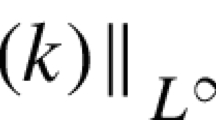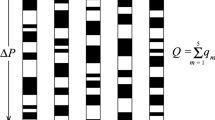Abstract
A continuum model of coherent structures in two-dimensional magnetohydro-dynamic turbulence is developed. These structures are macroscopic states which persist among the turbulent microscopic fluctuations, typically as magnetic islands with flow. They are modeled as statistical equilibrium states for the non-dissipative dynamics, which conserves energy and families of cross-helicity and flux integrals. The model predicts that from a given initial state an ideal magnetofluid will evolve into a final state having steady mean magnetic and velocity fields, and Gaussian local fluctuations in these fields. Excellent qualitative and quantitative agreement is found with the known results of direct numerical simulations. A rigorous justification of the theory is also provided, in the sense that the continuum model is derived from a lattice model in a fixed-volume, small-spacing limit. This construction uses the discrete Fourier transform to link the discretization ofx-space with the truncation ofk-space. Under the ergodic hypothesis and a separation-of-scales hypothesis, the lattice model is defined by a mean-field approximation to the Gibbs measure on the discretized phase space. A concentration property shows that this measure is equivalent to the microcanonical measure in the continuum limit.
Similar content being viewed by others
References
R. Balescu,Equilibrium and Nonequilibrium Statistical Mechanics (Wiley, New York, 1975).
R. Balian,From Microphysics to Macrophysics, I (Springer-Verlag, Berlin, 1991).
P. Billingsley,Probability and Measure (Wiley, New York, 1986).
D. Biskamp,Nonlinear Magnetohydrodynamics (Cambridge University Press, Cambridge, 1993).
D. Biskamp and H. Welter, Dynamics of decaying two-dimensional magnetohydro-dynamic turbulence,Phys. Fluids B 1:1964 (1989).
D. Biskamp and H. Welter, Magnetic field amplification and saturation in two-dimensional magnetohydrodynamic turbulence.Phys. Fluids B 2:1787 (1990).
D. Biskamp, H. Welter, and M. Walter, Statistical properties of two-dimensional magnetohydrodynamic turbulence,Phys. Fluids B 2:3024 (1990).
M. E. Brachet, M. Meneguzzi, H. Politano, and P. L. Sulem, The dynamics of freely decaying two-dimensional turbulence,J. Fluid Mech. 194:333 (1988).
C. Canuto, M. Y. Hussain, A. Quateroni, and T. Zang,Spectral Methods in Fluid Dynamics (Springer-Verlag, New York, 1985).
A. J. Chorin,Vorticity and Turbulence (Springer-Verlag, New York, 1994).
R. S. Ellis,Entropy, Large Deviations and Statistical Mechanics (Springer-Verlag, New York, 1985).
A. Eydeland, J. Spruck, and B. Turkington, Multi-constrained variational problems of eigenvalue type: New formulations and algorithms,Math. Comput. 55:509 (1990).
D. Fyfe and D. Montgomery, High-beta turbulence in two-dimensional magnetohydro-dynamics,J. Plasma Phys. 16:181 (1976).
A. V. Gruzinov, Gaussian free turbulence: Structures and relaxation in plasma models,Comments Plasma Phys. Controlled Fusion 15:227 (1993).
D. Holm, J. Marsden, T. Ratiu, and A. Weinstein, Nonlinear stability of fluid and plasma equilibria,Rev. Mod. Phys. 123:1 (1985).
A. D. Ioffe and V. M. Tihimirov,Theory of Extremal Problems (North-Holland, Amsterdam, 1979).
M. B. Isichenko and A. V. Gruzinov, Isotopological relaxation, coherent structures, and Gaussian turbulence in two-dimensional magnetohydrodynamics,Phys. Plasmas 1:1801 (1994).
E. T. Jaynes, Information theory and statistical mechanics,Phys. Rev. 106:620 (1957).
R. Jordan, A statistical equilibrium model of coherent structures in magnetohydro-dynamics,Nonlinearity 8:585 (1995).
R. Jordan and B. Turkington, Maximum entropy states and coherent structures in magnetohydrodynamics, inMaximum Entropy and Bayesian Methods (Dordrecht, Kluwer, to appear).
R. Kinney, J. C. McWilliams, and T. Tajima, Coherent structures and turbulent cascades in two-dimensional incompressible magnetohydrodynamic turbulence,Phys. Plasmas 2:3623 (1995).
R. H. Kraichnan and D. Montgomery, Two-dimensional turbulence,Rep. Prog. Phys. 43:547 (1980).
T. D. Lee, On some statistical properties of hydrodynamical and magnetohydronamical fields,Q. Appl. Math. 10:69 (1952).
A. E. Lifshitz,Magnetohydrodynamics and Spectral Theory (Kluwer, Dordrecht 1989).
D. Lynden_Bell, Statistical mechanics of violent relaxation in stellar systems,Monthly Notices R. Astron. Soc. 136:101 (1967).
J. C. McWilliams, The emergence of isolated, coherent vortices in turbulent flow,J. Fluid Mech. 146:21 (1984).
J. Miller, Statistical mechanics of Euler equations in two-dimensions,Phys. Rev. Lett. 65:2137 (1990).
J. Miller, P. B. Weichman, and M. C. Cross, Statistical mechanics, Euler's equation, and Jupiter's Red Spot,Phys. Rev. A 45:2328 (1992).
D. Montgomery, L. Turner, and G. Vahala, Most probable states in magnetohydro-dynamics,J. Plasma Phys. 21:239 (1979).
L. Onsager, Statistical hydrodynamics,Nuovo Cimento 6:279 (1949).
H. Politano, A. Pouquet, and P. L. Sulem, Inertial ranges and resistive instabilities in two-dimensional magnetohydrodynamic turbulence,Phys. Fluids B 1:2330, (1990).
R. Robert, A maximum entropy principle for two-dimensional perfect fluid dynamics,J. Stat. Phys. 65:531 (1991).
R. Robert and J. Sommeria, Statistical equilibrium states for two-dimensional flows,J. Fluid Mech. 229:291 (1991).
J. V. Shebalin, Broken ergodicity and coherent structure in homogeneous turbulence,Physica D 37:173 (1989).
J. Stoer and R. Bulirsch,Introduction to Numerical Analysis (Springer-Verlag, New York, 1980).
A. C. Ting, W. H. Matthaeus, and D. Montgomery, Turbulent relaxation processes in magnetohydrodynamics,Phys. Fluids 29:3261 (1986).
B. Turkington and R. Jordan, Turbulent relaxation of a magnetofluid: A statistical equilibrium model, inAdvances in Geometric Analysis and Continuum Mechanics (International Press, Boston, 1995), pp. 124–137.
B. Turkington, A. Lifshitz, A. Eydeland, and J. Spruck, Multiconstrained variational problems in magnetohydrodynamics: Equilibrium and slow evolution,J. Comput. Phys. 106:269 (1993).
L. Woltjer, Hydromagnetic equilibriums III,Astrophys. J. 130:400 (1959).
Author information
Authors and Affiliations
Rights and permissions
About this article
Cite this article
Jordan, R., Turkington, B. Ideal magnetofluid turbulence in two dimensions. J Stat Phys 87, 661–695 (1997). https://doi.org/10.1007/BF02181242
Received:
Accepted:
Issue Date:
DOI: https://doi.org/10.1007/BF02181242




